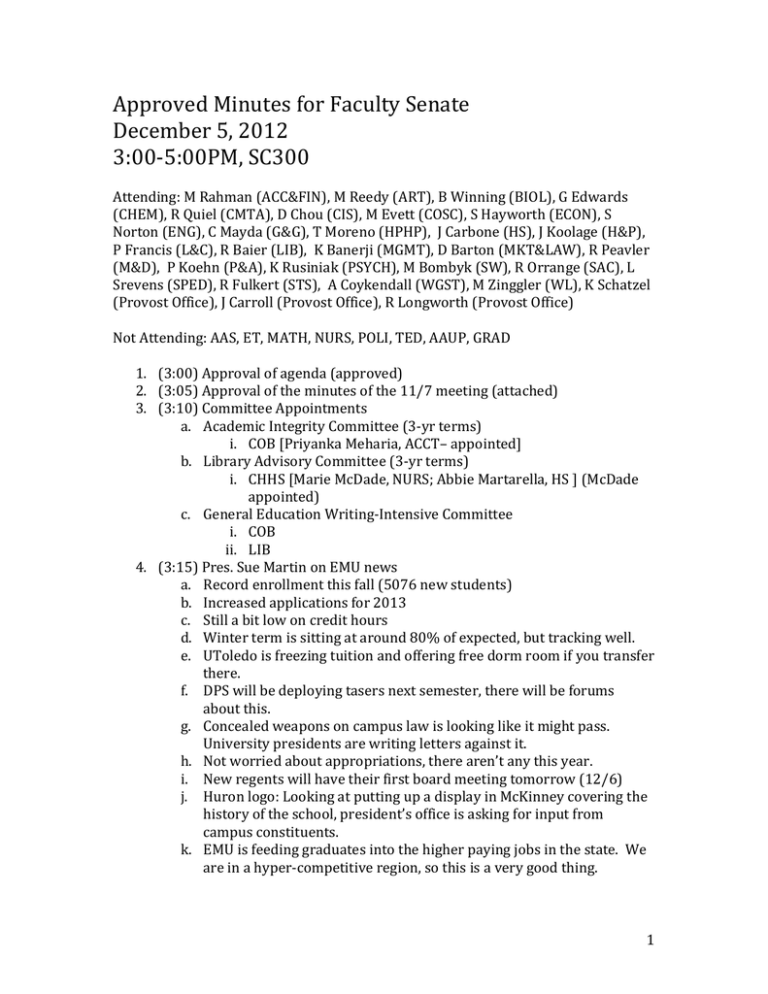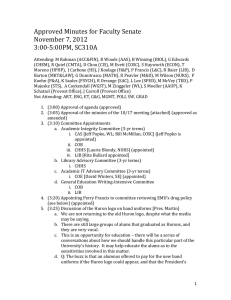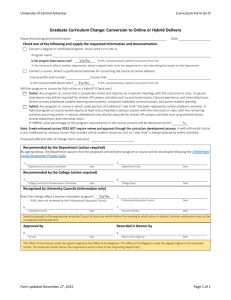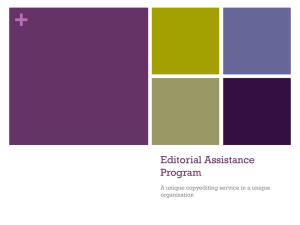Approved Minutes for Faculty Senate December 5, 2012 3:00-5:00PM, SC300
advertisement

Approved Minutes for Faculty Senate December 5, 2012 3:00-5:00PM, SC300 Attending: M Rahman (ACC&FIN), M Reedy (ART), B Winning (BIOL), G Edwards (CHEM), R Quiel (CMTA), D Chou (CIS), M Evett (COSC), S Hayworth (ECON), S Norton (ENG), C Mayda (G&G), T Moreno (HPHP), J Carbone (HS), J Koolage (H&P), P Francis (L&C), R Baier (LIB), K Banerji (MGMT), D Barton (MKT&LAW), R Peavler (M&D), P Koehn (P&A), K Rusiniak (PSYCH), M Bombyk (SW), R Orrange (SAC), L Srevens (SPED), R Fulkert (STS), A Coykendall (WGST), M Zinggler (WL), K Schatzel (Provost Office), J Carroll (Provost Office), R Longworth (Provost Office) Not Attending: AAS, ET, MATH, NURS, POLI, TED, AAUP, GRAD 1. (3:00) Approval of agenda (approved) 2. (3:05) Approval of the minutes of the 11/7 meeting (attached) 3. (3:10) Committee Appointments a. Academic Integrity Committee (3-yr terms) i. COB [Priyanka Meharia, ACCT– appointed] b. Library Advisory Committee (3-yr terms) i. CHHS [Marie McDade, NURS; Abbie Martarella, HS ] (McDade appointed) c. General Education Writing-Intensive Committee i. COB ii. LIB 4. (3:15) Pres. Sue Martin on EMU news a. Record enrollment this fall (5076 new students) b. Increased applications for 2013 c. Still a bit low on credit hours d. Winter term is sitting at around 80% of expected, but tracking well. e. UToledo is freezing tuition and offering free dorm room if you transfer there. f. DPS will be deploying tasers next semester, there will be forums about this. g. Concealed weapons on campus law is looking like it might pass. University presidents are writing letters against it. h. Not worried about appropriations, there aren’t any this year. i. New regents will have their first board meeting tomorrow (12/6) j. Huron logo: Looking at putting up a display in McKinney covering the history of the school, president’s office is asking for input from campus constituents. k. EMU is feeding graduates into the higher paying jobs in the state. We are in a hyper-competitive region, so this is a very good thing. 1 l. Strategic planning includes online efforts – we can lost market share without it, but we won’t gain market share with it. m. Q: Are the tasers currently outlawed on campus? A: Yes, if you have a CCW permit. n. Q: Huron logos keep showing up on campus – some sort of Pandora’s Box got opened here. What’s up with that? A (President): The university is contacting the groups using this logo. o. Suggestion: Instead of an exhibit, perhaps a community conference might be a better idea – getting constituents together to talk about the Huron issues. p. Q: Why has here been no repercussions for using the Huron logo? A (President): Not going to go into that now. q. Q: Is there any research about the impact of the CCW permits on campus? r. Comment: Many studies have shown that where there are guns, there is more violence, offered to send the President’s office the research. 5. (3:35) Updates to the advising system [Rhonda Longworth] a. We are moving to a more data-driven approach to student success measures. We are focusing on GPA, in addition to overall satisfaction with campus and retention. b. We will work with (starting in January) with the Student success council to put together a comprehensive plan for student retention. c. Looking at professionalized advising, increasing the level of support for advising. d. 3 positions for CAS and “intent” advising, housed here in the Student Center. Looking at an “Apple Store” kind of environment, including a “Genius Bar.” e. Material will be sent to the student in whatever format they want (email, text, etc). f. Will use a more modernized approach to advising, including program construction, building career services into the process. We want to give them a *plan* for their time here. g. Pushing hard to enhance the process with technology. Video versions of skills tests and online feedback will be offered, in addition to the inperson activities. All electronic systems will be linked (Banner, registration, course schedules, course descriptions, etc., all tied together). h. Also looking at note-taking systems so that advisors can see what previous advisers have told them. i. Stray things: QR code readers, currently used to track attendance at study tables and at LBC events. j. Still working on the FastTrack program. Students are given folders (samples were distributed at meeting) with information about getting through their education in 4 years. k. Students will receive an *automatic* General Education audit at 60 credits, and a notice at 90 credits if a major hasn’t been declared. 2 l. Q: Will studnts that have a major be excluded? A: No, they will never be pushed out of the system. m. Comment: The Senate has made it very clear that there is a structural problem at EMU. Our students cannot carry a 15 credit load – and we are encouraging them to do this! We are setting up students for failure by encouraging them to take 15 credit hours per semester. We’ve been arguing this for a long time. Provost: We will come back and talk about that. We will have a followup session. 5a. Grant Thornton Admissions a. Made a strong effort to bring technology into our processes. This group is here to talk about process applications, specifically for grad programs (admissions) and transfer students. b. Key is to get students engaged as soon as possible, even before admission. c. There is no change in roles, decision processes or criteria. Material will be distributed to the appropriate locations more efficiently, but the admissions evaluation and decisions are unchanged. d. 2/3 of student enrollments come from EMU and 12 nearby schools. e. Step 1 – student must apply, getting information into the system. Grad students are a little faster, transfers were a little slower, not a huge difference. f. Step 2 – decision making. For transfer students, it was around a 5day wait. Graduate student decisions took longer, 20-25 days. g. Handout: Number of applicants used in this study, the number admitted. h. Result of all time increments is a 10-week backlog. The proposed system will improve information workflow. Right now we have a manual process, very inefficient. With the new system, application information is integrated with Banner. E-mails are automatically sent to grad programs. i. Web interface will be easier to use, more instructive. j. Electronic transcripts are supported by the system, but will not be part of the January rollout. k. Expected impact is more enrolled graduate student with less work. l. It will be easier to tell applicants where they are in the pipeline. m. Q: Can we use this system to track current students? A: Yes. n. Q: Can we use this to recruit more students, and how do we handle international students? A: The web application is completely contextual to international students as they answer the application questions. Information is automatically sent to the appropriate offices. 3 6. (3:50) NCAA Compliance [Michael Paciorek, Chris Hoppe (Assoc. Athletic Director)] a. University is responsible for making sure all rules and regulations are followed. b. Dr. Liz Broughton is the Faculty Athletics representative. Acts as liason between athletics and faculty. c. In general, coaches should not contact faculty, there are intermediaries. d. Students may not miss class for practice, team or individual meetings. They should provide faculty with travel schedules. e. Student-athletes may not receive extra benefits (special deadlines, etc). f. Faculty may not recruit athletes. They *can* notify the coach about potential recruits. 7. (4:05) Resolution: defining “online” courses (see below) a. Comment: It came up that it would be good to understand exactly why we are defining items. What’s the motivation? i. This is student-centric. There have been a “large number” of students having issues with our online/hybrid courses. ii. We also need to be efficient with facilities use. b. Comment: What is meant by “a lot?” How many are complaining? Provost: If even one asks, and I can’t answer, that’s “a lot”. c. Comment: It is not really feasible to produce a schedule of meeting times for the online course schedule. It would work in the syllabus, however. d. Comment: Hybrids are described in very general terms at other universities – “approximate” is used a lot. e. Friendly amendment: Change the word “deliver” to “meet.” Amendment accepted. f. Comment: Rigid criteria is a pedagogical hindrance, and this criteria can be used “as a sword”. g. One opposed, rest approved as amended. 8. (4:20) Provost request for input on a new course shelving policy (see attached) 9. (4:25) Provost Office’s Q&A 10. (4:35) Committee Reports a. EEFC [Patrick Koehn] b. Univ. Budget Comm. [Mahmud Rahman] c. eFellows/FDC [Randy Baier] d. Strategic Planning [Matt Evett]. (How would you define “school of opportunity”?) e. IT Steering Committee [Matt Evett] 11. (4:55) President’s Remarks a. Board of Regents Faculty Affairs Committee meeting is tomorrow, 10AM, 4 b. The next Senate meeting is Jan. 16, SC300. Next Executive Board meeting is Jan. 9, SC320 5 Responding to the Provost’s Request for Input on the Definition of Online Courses On October 26, 2012, the Provost’s Office requested input on a proposed definition of online courses at Eastern (see attached). The Faculty Senate has examined the proposed policy defining on-line courses. We object to the relative rigidity of some aspects of the definition. We suggest three changes: The sentence “A ‘hybrid class’ is a section of a for-credit course delivered 50% in-person and 50% on-line” be changed to “A ‘hybrid class’ is a section of a for-credit course delivered less than 100% in-person and the remainder on-line.” The sentence “A hybrid class must include an in-person session in the first and last week of the term” to be “A hybrid class must include an in-person session in the first week and, for those classes that require a course evaluation, another in-person session toward the end of the term.” The sentence “The dates and times of all the in-person sessions must be identified in the course schedule” be changed to “The dates and times of all the in-person sessions must be identified in the course syllabus.” From Jim Carroll, 10/26/2012: The Provost’s office is requesting input on the following definitions An “in-person class” is a section of a for-credit course delivered 100% in-person (face-to-face). A course section must be identified in the course schedule (using Banner codes) as an in-person class before the students begin enrolling in the class. The dates and times of the in-person class must be identified in the course schedule. An in-person class may use web-based portals to deliver course materials, but these materials should not substitute for in-person sessions. A “hybrid class” is a section of a for-credit course delivered 50% in-person and 50% on-line. A course section must be identified in the course schedule (using Banner codes) as a hybrid class before students begin enrolling in the class. A hybrid class must include an in-person session in the first and last week of the term. 6 The dates and times of all the in-person sessions must be identified in the course schedule. An “on-line class” is a section of a for-credit course delivered 100% on-line. A course section must be identified in the course schedule (using Banner codes) as an on-line class before students begin enrolling in the class. As an exception, an on-line class may have one (1) scheduled in-person class session with students during the semester. If the course has an in-person session scheduled, the date of that session must be identified in the course schedule before students register for the course. Any course may be delivery as in-person classes, hybrid classes, and/or on-line classes. The primary need for these definitions is to clarify the expectations and the differences between in-person, hybrid, and on-line classes for the students, faculty, departments, and the colleges before the students begin registering for the classes. The percentages above are based on a 50 minute in-person session per week during a 15 week semester being equivalent to 1 credit hour. Courses with additional contact hours are expected to follow the same percentages of the course contact hours. Input from Faculty Senate is requested by November 30. Strategic Planning DRAFT (6/7/12) EMU Mission Statement Eastern Michigan University enriches lives in a supportive, intellectually dynamic and diverse community. Our dedicated faculty balance teaching and research to prepare students with relevant skills and real-world awareness. We are an institution of opportunity where students learn in and beyond the classroom to benefit the local and global communities. DRAFT 10/23/12 EMU Vision Statement Eastern Michigan University will be a premier public university in the 21st century. By building high-quality academic programs, expanding domestic and global partnerships, and implementing innovative and student-centered initiatives, we will be recognized for our creative learning opportunities, service and engagements, and economic and social impact. 7 EMU Strategic Planning: Mission, Vision and Values I. Suggested Values A. Teaching and Learning – Teaching and learning are central to everything that we do. We are a community of learners who discover, interpret, apply and transmit knowledge. A scholarly environment that promotes research, discovery, interpretation, application and transmission of knowledge B. Student Success – It is the priority of the institution to ensure the full educational experience, which includes the preparation of student careers, the attainment of degrees and contributing well-rounded and grounded students to the community. C. Excellence –We are committed to an exceptional quality learning environment to our faculty, staff, and students. We believe in “Education First.” D. Human Dignity and Respect –Sound judgment, acceptance and respect for other persons, ideas, cultures, religions, diversity, and inclusiveness are our characteristics. We seek to demonstrate, through all programs, activities and services, an appreciation for human diversity and an atmosphere of mutual respect and support for individual differences. We create an inclusive educational environment that provides exceptional opportunities for all. E. Scholarship and Intellectual Freedom –We promote, encourage and support academic freedom. We provide creative learning experiences through intellectual and cultural exchange. F. Community Engagement – We value community engagement as part of the University’s mission. G. Leadership and Participatory Decision-Making – We create and support a collaborative environment that fosters open communication. H. Integrity – Integrity and transparency are critical to our institutional effectiveness. We support the highest level of personal, intellectual, academic, financial and operational integrity within the University community. 8 Committee Appointments Library Advisory Board CHHS Marie McDade I am a new faculty within the CHHS School of Nursing. I am writing to express interest in serving on the university-wide Library Committee. Because I am a new faculty, I have limited experience serving on committees. However, I am quite passionate about learning and the contribution that a strong library makes on learning and academic success. In addition to being a new faculty at EMU, I am an alum that graduated from EMU with a Bachelor of Science in Nursing. I matriculated to EMU in 2000 and spent countless hours utilizing library services at Halle. I have always been impressed with the full array of services and materials that are available to help students succeed. After graduating from EMU, I matriculated to the University Of Michigan where I completed a Master of Science in Psychiatric Mental Health Nursing and where I am a PhD candidate soon to defend my dissertation. I point this out because I still regularly utilize Halle as a resource for needed books, articles, and databases. I am a current recipient of the federal government’s Substance Abuse and Mental Health Services Administration (SAMHSA) Minority Fellowship Program award, and I recently served on the planning committee for the 2011 SAMHSA’s “Weaving the Tapestry of Health: Improving Behavioral Health in Diverse Populations Through Science and Cultural Sensitivity” conference. I am currently serving on the Curriculum and Instruction Committee within the School of Nursing and would look forward to serving on the university-wide Library Committee as well. Educationally yours, Marie McDade 9


